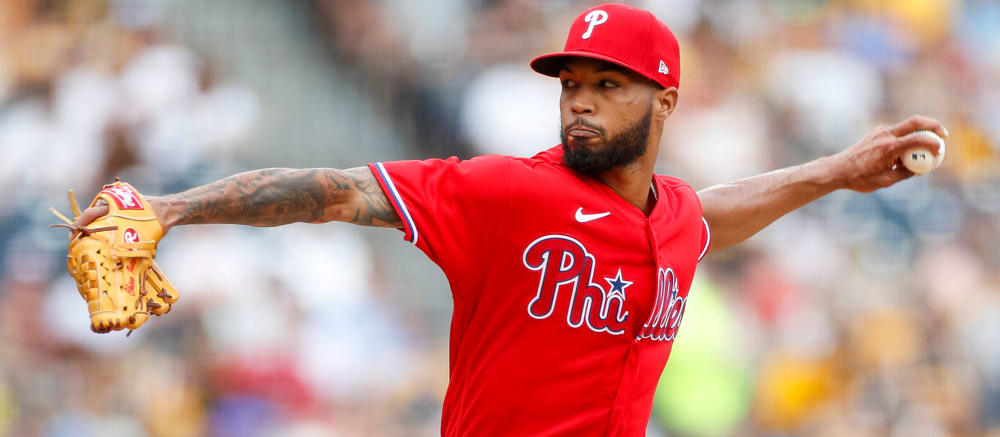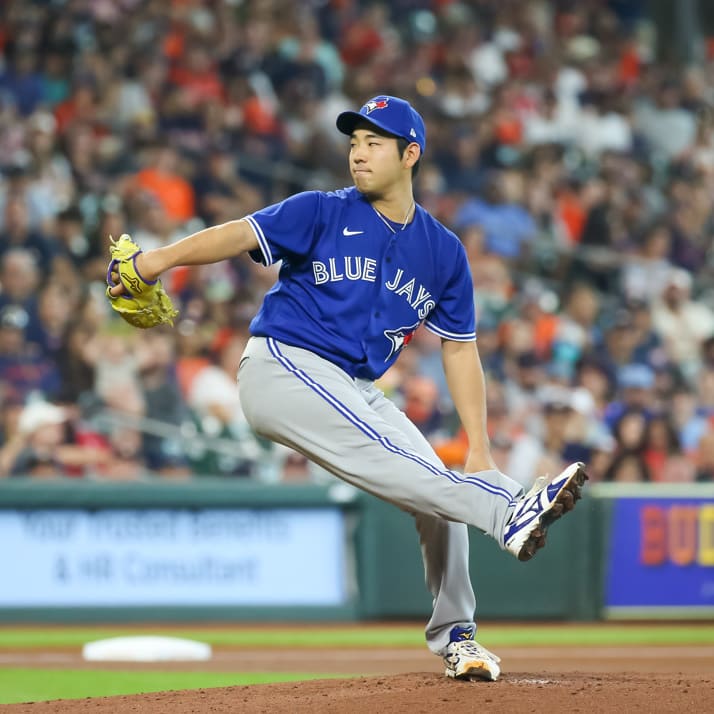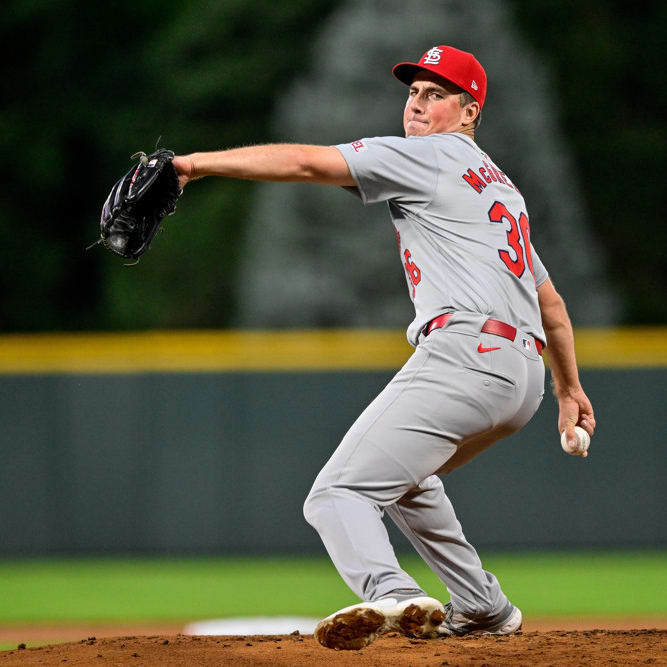This article is part of our Collette Calls series.
Every season, someone ends up finishing as a first rounder or on the very edge of first-round value like a Randy Orton RKO out of nowhere. Ryan Bloomfield of BaseballHQ poses the question to his Twitter followers each year asking for nominations for who will be the player who leaps somewhere after pick 180 into the top 15-20 value by season's end. I would share previous guesses with you, but my Twitter paper trail has gone the way of Sidd Finch. I was able to find his reference from this time last season where he reminded us of the the list of players of the past nine seasons who have made the leap from after the 12th round in 15-round formats and into the first round by season's end.
Let's take a look back at the player writeups for each player the season of their breakout.
2015 - Dallas Keuchel - ADP 230
After two straight seasons with an ERA above five, Keuchel came out of nowhere to establish himself as a premier pitcher in 2014. The left-hander reached 200 innings exactly, going 12-9 with a 2.93 ERA and leading the AL with five complete games. His groundball rate (2.83 GO/AO) was the best in the majors by far and he led all pitchers in total chances (66) and assists (47) to win the AL Gold Glove award. Keuchel's 3.21 FIP indicates his success was no fluke, and his remarkable season puts him in line to start Opening Day for
Every season, someone ends up finishing as a first rounder or on the very edge of first-round value like a Randy Orton RKO out of nowhere. Ryan Bloomfield of BaseballHQ poses the question to his Twitter followers each year asking for nominations for who will be the player who leaps somewhere after pick 180 into the top 15-20 value by season's end. I would share previous guesses with you, but my Twitter paper trail has gone the way of Sidd Finch. I was able to find his reference from this time last season where he reminded us of the the list of players of the past nine seasons who have made the leap from after the 12th round in 15-round formats and into the first round by season's end.
Let's take a look back at the player writeups for each player the season of their breakout.
2015 - Dallas Keuchel - ADP 230
After two straight seasons with an ERA above five, Keuchel came out of nowhere to establish himself as a premier pitcher in 2014. The left-hander reached 200 innings exactly, going 12-9 with a 2.93 ERA and leading the AL with five complete games. His groundball rate (2.83 GO/AO) was the best in the majors by far and he led all pitchers in total chances (66) and assists (47) to win the AL Gold Glove award. Keuchel's 3.21 FIP indicates his success was no fluke, and his remarkable season puts him in line to start Opening Day for the Astros in 2015.
2016 - Jonathan Villar - ADP 317
Villar secured an Opening Day roster spot with the Astros after hitting .288 and displaying increased versatility on defense last spring, but he only made 53 appearances for the club and was limited to spot-start and pinch-running duties. Quite simply, the door never opened for regular playing time, as Luis Valbuena, Jed Lowrie and Marwin Gonzalez saw most of the at-bats behind stars Jose Altuve and Carlos Correa. The 24-year-old did not allow that to slow him down, however, as he swiped 35 bases in 70 games with Triple-A Fresno. A November trade to Milwaukee cleared Villar's path considerably, he will likely serve primarily in a utility role so long as Jean Segura is in town.
2017 - Aaron Judge - ADP 340
Long viewed as one of the top prospects in the Yankees system, Judge got a chance to make his major league debut last season. Following the trade deadline departure of Carlos Beltran, the 6-foot-7, 275-pound Judge was immediately inserted into an everyday role in right field. After smacking 19 home runs in the minors, Judge got off to a terrific start in the majors with homers in his first two games while hitting over .300 in his first week, but a lot of worrisome issues cropped up after that. The 24-year-old struck out at an alarming 44.2 percent clip and ended up hitting just .179 before a Grade 2 oblique strain ended his season. While his elite raw power was never questioned in the minors, he had some seasons where he posted strikeout rates above 25 percent, and the worry was always that big league pitching would be able to exploit his size, resulting in low batting averages. That appears to be exactly what happened last season. Winning the starting right field job is all but guaranteed, and Judge could be a solid source of power, but the questions about his hit tool make this an extremely volatile profile.
2018 - Blake Snell - ADP 196
Snell has mostly struggled so far at the highest level, failing to meet the hype as a former top prospect, but he made strides late in 2017 and may be on the verge of a breakout. The young left-hander shaved a full walk from his BB/9 from the previous season (to 4.1) and got sharper as the season wore on, posting a 2.9 BB/9 in the second half. Meanwhile, Snell added to his strikeout percentage in each of the season's final three months, finishing with a 26.5-percent mark in September, while also trimming his HR/9 from 1.21 to 0.93 from the first half to the second half. It's not uncommon for pitchers to struggle with fastball command like Snell did with the jump to the big leagues; Snell seems to have regained his trust in the pitch, but continuing to locate well will be critical to his success moving forward. With plenty of owners disappointed by his struggles last season, Snell's second-half improvement may not be baked into his price on draft day.
2019 - Ketel Marte - ADP 211
Marte got a chance to play close to every day in the major leagues in his age-24 season, and the final numbers were fine if unspectacular. He struck out just 25 more times than he walked in 580 plate appearances, and he added more than 40 points to his ISO. That rate-power boost came in large part thanks to his major-league-leading 12 triples. For a player with his pure speed, he sure didn't attempt many stolen bases as manager Torey Lovullo took a more conservative approach on the basepaths. But at least when he did run, Marte was successful (6-for-7). In total, his offenses contributions added up to a 104 wRC+, so better than league average. It's tough to bank on Lovullo changing his philosophy in the running game, but it's possible he swings more to the aggressive side again after Arizona tore it down this offseason. Either way, Marte should be useful on volume alone. The dual eligibility (shortstop and second) helps his case.
2020 - Luke Voit - ADP 297
After a spectacular debut campaign in the Bronx, Voit came back to earth last season as his .263 batting average, 20.4 AB/HR and .200 ISO were merely mortal compared to his output in 2018. Still, Voit's final numbers would have looked better if not for a sports hernia that cost him most of August and a subsequent 1-for-32 slump to conclude the regular season. Voit proved to be a valuable presence near the top of the lineup by ranking fifth in the American League in walk rate (13.9%) and ninth in OBP (.378) last season. Those numbers make his troubling 27.8 K% more palatable, especially with a slew of hitters below him capable of driving in runs. Voit's hard-hit rate dropped precipitously in 2019 while his average exit velocity dipped from 93.0 mph to 89.7 mph; he's likely to fall somewhere between those extremes and settle in as an above-average source of power and counting stats in 2020.
2021 - Cedric Mullins - ADP 411
Mullins didn't do much to separate himself from a large group of fringy outfielders in Baltimore, but he at least looked like a legitimate big-leaguer, something that couldn't be taken for granted after he hit a miserable .094/.181/.156 in 22 games in 2019. His .271/.315/.407 slash line this time around was good for a still below-average 95 wRC+, but when combined with good speed (seven steals) and roughly average defense in center, that's a useful enough player. Role questions remain for Mullins, however, as other Oriole outfielders also took steps forward. Additionally, there are questions about whether he can maintain his 2020 level. His 24.2 K% and 5.2 BB% showed poor plate discipline, and he had an awful 2.8% barrel rate. Statcast hated his quality of contact, giving him a .209 xBA and .296 xSLG. Despite his wheels and respectable numbers, Mullins still has work to do to prove he's an everyday player.
2022 - Adolis Garcia - ADP 182
Texas designated Garcia for assignment before spring training, but he cleared waivers and was a non-roster invitee. He didn't make the roster but was soon summoned from the alternate training site. An early power binge and his ability to play center earned Garcia regular playing time and an All-Star berth. He was slashing .270/.312/.527, doing most of his damage with a .988 OPS on fastballs, though a 30.6 K% and a 4.8 BB% portended a second-half swoon. Garcia slashed .208/.260/.387 the rest of the way, cratering to a .532 OPS on fastballs. Garcia's average exit velocity on fastballs didn't change much, but he posted a .402 BABIP on the pitch pre-break and .235 after. He has power with 83rd percentile sprint speed but poor plate skills. His skill level is between the extremes and will depend on BABIP fortune. A slow start could cost him playing time, but plus defense helps. Pay for counting stats but buffer a low average.
2023 - Cody Bellinger - ADP 187
While his 2022 constituted a bounce-back to a degree, it wasn't enough as Bellinger was non-tendered by the Dodgers in November just three years after he won National League MVP. It's a dramatic fall from grace but should also serve as a reminder of just how incredibly difficult it is to not only achieve success but sustain success at the highest level of professional baseball. His strikeout rate was high when he first broke into the majors (when he won NL Rookie of the Year), but he's been unable to overcome the swing-and-miss in recent seasons. Bellinger lost patience as his struggles mounted and failed to hit for the kind of rate power we saw earlier in his career. Still just 27 years old, Bellinger can run (14 steals last season) but has to be considered a laborious reclamation project at this point since even the Dodgers -- the best team in the game in terms of development -- weren't able to fix him. The Cubs brought him in on a one-year, $17.5 million deal to open the year as their starting center fielder.
Aside from Keuchel's writeup, none of these preseason player profiles were particularly glowing reviews or leading indicators of what was to come in that player's breakout season. The reminder here is that value can come from anywhere, but once we get past the 12th round, we're all looking for lightning in a bottle given that the chances of a player picked 180 turning into a first-round value is but one a season.
So, let's find that one. For the purpose of this exercise, I will not repurpose anyone from my recently completed Bold Prediction Series nor will I use anyone from the Value in the Scrap Heap article from late November. I am specifically looking at one hitter and one pitcher here in what will likely be an exercise in futility given the odds.
We should first accept that these types of jumps are a young man's game and that older hitters and pitchers do not make this kind of leap. This brought my search down to players under the age of 30. One hitter and one pitcher stood out to me in this quest to find the one player who could make the leap from the middle rounds to the first round. Below is what our player profiles said about the hitter and pitcher I have zeroed in on:
In 2020, Hitter X improved selectivity, but he hit the ball with less authority. Last season, he regained some aggressiveness, establishing a new career best with 94th percentile average exit velocity and 93rd percentile hard-hit rate. The improvement began in 2020 when he chased fewer sliders and curves while increasing contact on both. Last season, he kept this, adding a 5-mph jump in average exit velocity on breakers. Hitter X's plate skills are still suspect, but he found a combination allowing him to drive the ball with pitch recognition the key. This bodes well for continued growth as Hitter X's athleticism just needed improved baseball sense. Health is an issue as Hitter X lost time with groin, finger and back issues, though nothing appears chronic. Hitter X's defense remained a plus. Repeating last season's rate stats will be a challenge, but more playing time should keep counting stats bountiful.
Pitcher Y missed the last half of spring training with soreness in his left triceps. He came off the IL in late April to make a start in a doubleheader, then was optioned to Triple-A. Pitcher Y wasn't pitching well, but his club needed rotation help, so they recalled Pitcher Y in mid-June. Something clicked as the lefty went on to start 17 more games, with one relief appearance. His 3.44 ERA was fully supported by its estimators, though Pitcher Y benefited from a .272 BABIP, which is low for a pitcher with a 57 percent groundball rate. His four percent walk rate was much lower than previous seasons, while his 24.2 percent strikeout clip matched his minor-league track record. Pitcher Y isn't assured of a spot in the Opening Day rotation, but he merits a long look in the spring. He'll be hard-pressed to match his 1.05 WHIP as his BABIP is likely to increase as well as giving back some of the control gains exhibited lasts season. Pitcher Y's three-pitch mix, featuring a 92-mph sinker, changeup and slider doesn't portend a front-end starter, but Pitcher Y could be a reliable back-end fantasy guy, shielded from the most potent lineups
Those two profiles read much like the aforementioned group with tints of upside around guidance of what could go wrong as well. Scroll down a few lines to see who those profiles belong to.
scrolling
scrolling
scrolling
scrolling
scrolling
scrolling
scrolling
They belong to Tyler O'Neill and Cristopher Sanchez.
O'Neill was a $30 player in 2021, hitting .286 with 34 homers and 80 RBI while scoring 89 runs and stealing 30 bases in 138 games. That season remains the only full one O'Neill has given fantasy managers in his six years with St. Louis. He now takes his athleticism to Fenway. Ben Clemens did a fantastic job in January writing up how the change in location won't benefit O'Neill too much. The park change is neutral, so O'Neill will need a few breaks in order to realize a return to fantasy prominence. First, he has to stay on the field and log his first season of 500 at-bats. One would think someone as fit as O'Neill wouldn't have injury issues, but perhaps there is something to being overly in shape for baseball, as O'Neill already looks the part in Boston:
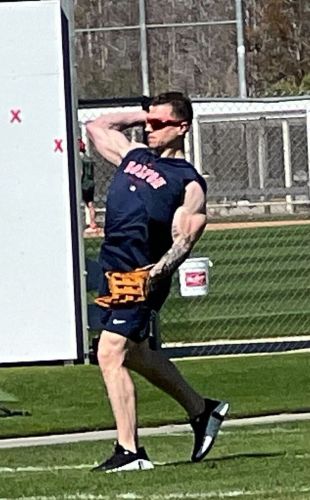
O'Neill will also need to rediscover his ability to make hard contact, as it's faded since peaking during his breakout season in 2021:
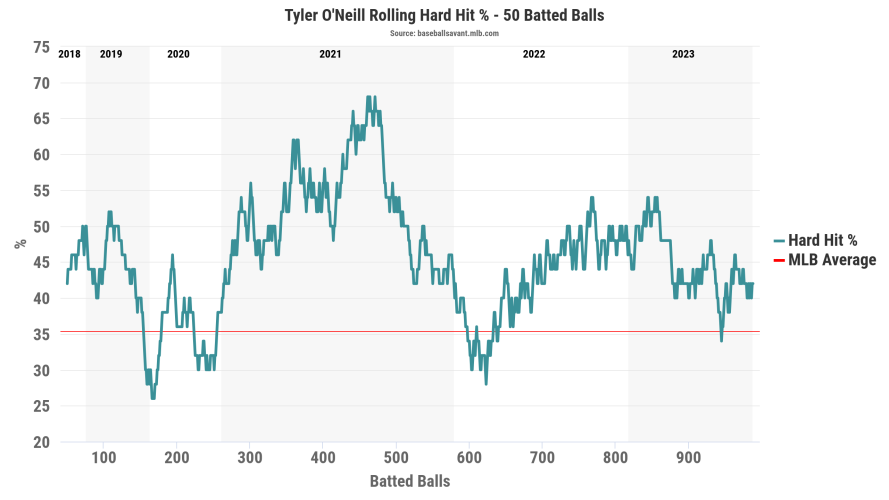
Finally, O'Neill has had issues against right-handed pitching over the past three seasons with a .260/.366/.511 line and a 22.8 percent strikeout rate against lefties but a .254/.318/.461 line against righties with a 30.2 percent strikeout rate.
Meanwhile, Sanchez has made the trade he was involved in for Curtis Mead look much less lopsided than it was judged to be this time last year. Sanchez pitched wonderfully down the stretch for Philadelphia and has earned a spot in their rotation this year. The previous leaps by pitchers were limited to Keuchel and Snell, who pitched for 86- and 90-win clubs respectively. A pitcher has to get the wins, strikeouts and the ratios in order to make the necessary leap from mid-round obscurity to the first round, which is why the list is so heavily tilted toward hitters. Hitters can overcome a lack of steals or power with heavy volume in the opposing category, while a pitcher who has bad ratios faces a stiff challenge to provide value in wins. Andy Pettitte, Rick Helling and David Wells all won 20 games with ERAs over 4.00 and WHIPs over 1.25, but that was also more than 20 years ago. In the past 10 years, Jason Vargas stands out with his 18 wins in 2017 alongside troubling ratios.
Sanchez is someone the club expects to make 25 to 30 starts this season as they were impressed by his command as well as his use of the changeup last year, which really stood out as the season wore on:
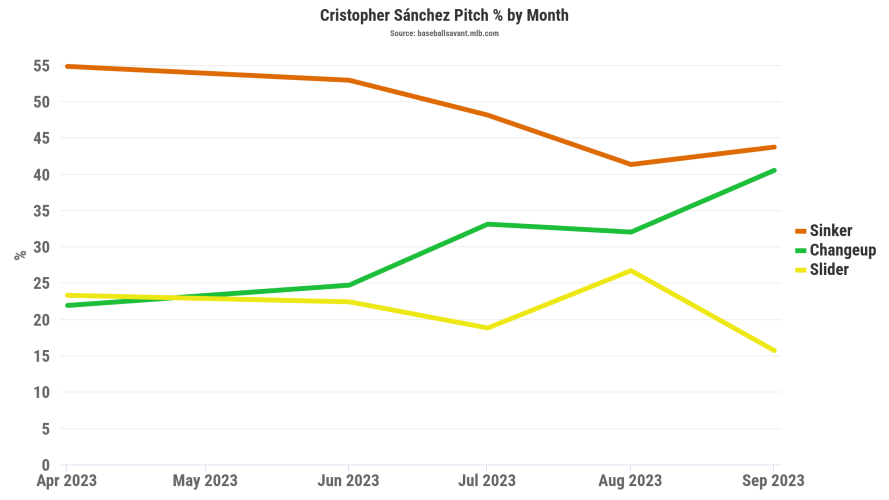
That changeup had a 43 percent whiff rate, and the league had a .165 xBA off the pitch. The challenge for Sanchez in becoming just the third pitcher to make the leap will be finding a way to do a better job limiting homers, as he allowed 16 last season, with 15 of them coming off righties despite that excellent changeup. Righties had a .349 xBA off Sanchez's fastball and a .289 xBA off his slider, a pitch they saw over 60 percent of the time. He could truly use another offering to throw righties. Perhaps a cutter that would come in on their hands would help? He was working on the shape of his slider last season, but there is still room for growth there as well. For now, Sanchez is a talented pitcher on a winning club with a strong bullpen behind him, so the conditions are there if all the breaks go his way.
At the end of the day, the odds are stacked against either player making the leap to a first-round finish. Yet every season in recent memory has seen one player do exactly that. O'Neill has an ADP of 228 in 70 Draft Champions draft since Jan. 1, while Sanchez is going a round behind him at pick 242. The talent is there for both players, but they will both need several things to break their way in order for one of them to claim the 2024 crown from Bellinger.

